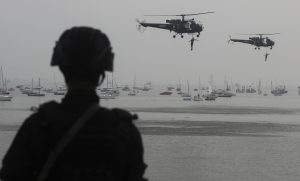The Indian Navy’s plans for hosting the 13th edition of its multinational exercise — MILAN 2020 — at India’s Eastern Naval Command at Vishakhapatnam in March, were quashed due to the outbreak of COVID-19. This was not an isolated event: the coronavirus has led several militaries around the world to cancel major events.
Nonetheless, although MILAN 2020 has been cancelled, the fact that India did plan to invite 42 navies, including almost all regional navies, for the event — with the notable exceptions of adversarial neighbors China and Pakistan, and Iraq and Yemen, grappling with internal turmoil and conflict — is instructive, and suggests a change in how India views the Indian Ocean.
Multinational naval exercises such as MILAN are central to reducing maritime risk and promoting regional maritime security cooperation. Indeed, several major navies host large-scale exercises such as the RIMPAC conducted by the U.S. Navy around the Hawaii islands every two years — in 2018, about 25 nations participated. Similarly, the Australian navy hosts exercise KAKADU which saw participation by 28 countries in 2018.
MILAN first began in 1995 at Port Blair, with four ASEAN states participating. It was an attempt by India to pacify Southeast Asian states apprehensive about India’s aspirations for power fueled by the rapid naval expansion programs of the 1980s. Southeast Asian states have embraced India as a regional partner.
Over the years, the exercise has grown in scale, and MILAN 2020 would have been among the largest multinational naval exercises ever, and probably the first time that the U.S. Navy would have been exercising with the Russian Navy. But, more importantly, the invitation for a large number of extra-regional navies signals a strategic shift in the way India views the Indian Ocean.
India’s View of the Indian Ocean
More than 60 years ago, G.M. Panikkar, widely regarded as one of India’s first and foremost maritime thinkers, argued that “since India’s future was dependent on the Indian Ocean, then the Indian Ocean must therefore remain truly Indian.” This greatly influenced India’s approach toward the Indian Ocean during the following decades post-independence, by which time India had acquired significant naval capacity, and in the late 1960s, India tried to assert its regional leadership by opposing the presence of extra-regional powers in the Indian Ocean.
In 1961, after India invaded Goa to free it from Portuguese rule, India’s first prime minister, Jawaharlal Nehru, justified his actions with reference to the American Monroe doctrine. Later prime ministers, including Indira Gandhi and Rajiv Gandhi, invoked this doctrine to justify India’s subsequent diplomatic and military interventions in Sri Lanka, Nepal, and the Maldives.
Around 1967, in the wake of the withdrawal of the Royal Navy from East of Suez and the entry of Soviet warships into the Indian Ocean for the first time in 1968, closely followed by the leasing of the island of Diego Garcia by the British to the United States in 1970 for use as an Indian Ocean naval base, India actively started opposing the presence of extra-regional powers in the Indian Ocean. And in December 1971, India engineered the passage of a UN General Assembly resolution for declaring the Indian Ocean as a “zone of peace” and “halting further escalation and expansion of military presence in the Indian Ocean.” However, following opposition to the proposals by the United States, the United Kingdom, China and France, the UN-appointed committee failed to reach consensus. By the end of the Cold War, New Delhi ceased alluding to the concept.
Current Thinking
India’s vision of keeping the Indian Ocean a “zone of peace” may have remained dormant since the 1990s, but in 2014 — by which time most world navies, particularly China, were operating in the India Ocean on anti-piracy patrols — India once again raised the issue of keeping the region free from foreign powers. During the 2014 Galle Dialogue in Sri Lanka, the Indian national security adviser, evoking the UN General Assembly resolution of 1971 for declaring the Indian Ocean as a “zone of peace,” called upon the “great powers not to allow escalation and expansion of military presence in the Indian Ocean.”
Until 2014, India’s position seems to have been aimed at curtailing growing Chinese maritime power, following in the wake of its massive trade and economic interests across the region. Over the past few years — particularly since the setting up of a PLA Naval base at Djibouti — China has made rapid progress in consolidating its naval presence in the Indian Ocean, and now seems positioned to undermine India’s regional leadership. At this point, an invitation to all leading world navies to participate in MILAN 2020 was perhaps a clear signal that in a changing world order and a fast-evolving regional environment, New Delhi is now open to engaging with other world powers in the Indian Ocean to balance growing Chinese influence. And it will be interesting to see how the largest naval exercise by the Indian Navy plays out whenever it is scheduled next.
Shishir Upadhyaya is a former Indian naval intelligence officer and geopolitical analyst. Currently, he is an associate professor at the Gujarat Maritime University.

































